Sudden Floor Collapse Claims the Lives of Two Fire Fighters and Four Are Hospitalized with Serious Burns in a Five-Alarm Fire - New York
 Death in the Line of Duty…A summary of a NIOSH fire fighter fatality investigation
Death in the Line of Duty…A summary of a NIOSH fire fighter fatality investigation
F98-17 Date Released: November 30, 1998
SUMMARY
On June 5, 1998, a call came into fire dispatch reporting a fire in the boiler room at residential/commercial complex. Several units were dispatched, and upon arrival, Engine 332 reported smoke emitting from the building. The building involved in the fire was one of five three-story wood frame dwellings (see Figure 1). The fire building (building #1) and the collapse building (building #2) were both owned by the City, with some of the units occupied and some vacant. The building, which had undergone renovations over the past several years, was built around the turn of the century. The fire department initiated fire fighting operations, and several fire fighters were conducting an interior attack on the first floor of one of the dwellings, when it was reported that a civilian was trapped on the second floor. The Captain (Victim #1) and a fire fighter on Ladder 176, the Lieutenant (Victim #2) and two fire fighters on Engine 332, and the Lieutenant on Ladder 103 went to the second floor to search for the trapped civilian. Without warning, approximately 10 minutes after the arrival of the first unit, the rear of the second floor of building #2 collapsed, trapping five fire fighters in a burning inferno on the first floor. NIOSH investigators conclude that, to minimize the chances of similar occurrences, fire departments should:
- ensure that Incident Command conducts a thorough initial size up of the incident before initiating fire fighting efforts, and continually evaluates the risk versus gain during operations at an incident
- ensure that Incident Command always maintains close accountability for all personnel at the fire scene
- ensure that some type of tone or alert that is recognized by all fire fighters be transmitted immediately when conditions become unsafe for fire fighters
- ensure that Rapid Intervention Crews/Teams or Firefighter Assist and Search Teams (FAST Truck) are in place in the early stages of an incident
- ensure that communication equipment used on the fireground, e.g., handie-talkies, will remain operational in the event that one unit malfunctions.
NIOSH investigators also concluded that, to prevent similar occurrences, municipalities should:
- ensure that modifications/renovations to buildings are in compliance with applicable building codes, i.e., any renovation or remodeling does not decrease the structural integrity of the supporting members.
INTRODUCTION
On June 5, 1998, several fire fighters were conducting an interior attack on the first floor of a wood frame, multiple residential dwelling, when it was reported that a civilian was trapped on the second floor. The Captain (Victim #1) and a fire fighter on Ladder 176, the Lieutenant (Victim #2) and two fire fighters on Engine 332, and the Lieutenant on Ladder 103 went to the second floor to search for the trapped civilian. The fire fighter on Ladder 176 went to the front and the other officers and fire fighters went to the rear of the structure to conduct a search. Within a few minutes and without warning, the floor at the rear of the structure collapsed, trapping all five in a live fire situation on the first floor. Two fire fighters died and four were seriously injured (includes the fire fighter on Ladder 176 that dove over the stairwell railing).
It was reported later that the trapped civilian had escaped through a back entrance.
On June 22-25, 1998, and September 15-17, 1998, an investigation of this incident was conducted by the Chief of the Trauma Investigations Section, Division of Safety Research. Meetings were conducted with the Chiefs of the Fire Department Safety Command (Fire Fighter Fatality Investigation Team), the Chief of Safety, the Safety and Health Coordinator, two Battalion Chiefs who responded to the incident, several fire fighters that responded to the incident, and a representative of the International Association of Fire Fighters (IAFF). A site visit was conducted; however, the building had already been removed. Copies of photographs from the incident site were obtained from the fire department along with diagrams of the buildings, a video tape of the incident, and investigative information which included a detailed time line. Figures, diagrams, and pictures used in this report were courtesy of the fire department.
The fire department involved in the incident serves a population of 7.9 million in a geographic area of 306 square miles. The fire department has 230 firehouses and is comprised of approximately 15,000 employees, including 11,000 fire fighters and officers, 3,000 emergency medical service (EMS personnel), and 1,000 civilians. The fire department provides all new fire fighters with the basic 13 weeks of training at their fire academy that meet or exceed the National Fire Protection Association (NFPA) Fire Fighter Level I and Level II. After graduating from the fire academy, the recruit fire fighters go through a 3-year rotation in which they are assigned to an A (high activity level), B (moderate activity level), or C (light activity level) firehouse for 1 year. They are then rotated to a different activity and geographic location for the second year, and rotated again at the beginning of the third year. Refresher training continues on each shift and multi-unit drills are conducted continually to maintain hands-on proficiency. The fire department has extensive written standard operating procedures. The Captain (Victim #1) had 20 years of fire fighting experience, and the Lieutenant (Victim #2) had 21 years of fire fighting experience.
Although many fire companies were involved in this five-alarm incident, only those directly involved up to the time of the fatal incident are discussed in this report.
INVESTIGATION
On June 5, 1998, at 2022 hours a call came into the Dispatch Center reporting a boiler room fire at a residential/commercial complex. The structure was one of five attached, three-story, wood-frame residential/commercial units (see Figure 1). Engine 332 (Lieutenant [Victim #2] and four fire fighters), Engine 231 (Lieutenant and four fire fighters), Engine 290 (Lieutenant and five fire fighters), Ladder l75 (Captain and five fire fighters), and Battalion 44 responded. Engine 332 was the first unit to arrive at 2025 hours, and reported a 1075 (working fire). Engine 332 and Engine 231 made hydrant connections close to the building and stretched hand lines to the front (see Figure 2). Fire fighters from Ladder 175 (Captain and five fire fighters) reported in at 2026 hours, and fire fighters from Engine 231 reported in at 2027 hours and attempted to make an entry on the first floor of building #1. Battalion 44 arrived at 2027 hours and was conducting a size-up, reporting heavy fire on the first floor of building #1, when he received a transmission from the fire fighters on the first floor of building #1 that the interior hall had been closed off from the rest of the building (the interior hall had been closed off during one of the renovations of the building). Battalion 44 told the fire fighters on Ladder 175 to breach the wall to gain access into the building. At that time, Battalion 44 called for an additional Engine and Ladder to be dispatched.
At 2029 hours, Ladder 176 (Captain [Victim #1] and six fire fighters) was designated as the Firefighter Assist and Search Team (FAST) Truck. Note: A FAST Truck is similar to a Rapid Intervention Crew/Team.
At 2029 hours Engine 290 arrived, followed by Ladder 103 at 2030 hours. Engine 332 and Engine 231 pulled lines to the front of the structure to prepare for making an interior attack. A woman who lived at building #2 reported to Battalion 44 that her mother was still in the building (see Figure 3). The Lieutenant and two fire fighters on Ladder 103 responded to the report that someone was trapped on the second floor. They were being assisted by the Lieutenant and three fire fighters on Engine 332.
At 2030 hours, dispatch notified Battalion 44 that Engine 227 (Captain and five fire fighters) and Ladder 111 (Lieutenant and five fire fighters) were the additional Engine and Ladder, and that Ladder 176 was the designated FAST Truck.
At 2030 hours, Engine 233 (Lieutenant and four fire fighters) arrived at the rear of the building and reported to Battalion 44 that heavy fire was showing in the rear. At 2031 hours, Ladder 175 breached a hole in the first floor hallway of building #1 to gain entrance into the first floor of the building. At 2032 hours, Engine 231 directed the line through the breached hole on the first floor of building #1. At the same time, the team on Ladder 103 (Lieutenant and five fire fighters) was at the rear entrance to the second floor apartment of building #2, and reported fire, heavy smoke, and heat on the second floor. Ladder 103 called Battalion 44 and requested a line. Battalion 44 ordered Engine 332 to pull a line to the second floor of building #2, and for the FAST Truck (Ladder 176) to assist in the search for the missing woman.
At 2032 hours, Battalion 44 called for a second alarm, which resulted in three more Engines, one additional Ladder, and the Maxi-water unit.
At 2034 hours Battalion 44 reported to the dispatcher that they were having trouble locating the fire, that people were trapped on the upper floors, and that searches were in progress. The Lieutenant on Ladder 103, and the Lieutenant (Victim #2), the Nozzleman, and a fire fighter on Engine 332 were conducting a search in the kitchen area on the second floor of building #2. The Captain (Victim #1) on Ladder 176 was searching the rear bedroom while a fire fighter on Ladder 176 went to the front of the apartment to search. The second floor was filled with heavy black smoke and heat, with no visible fire (fire fighters were unaware the fire was below them). The fire fighter searching the front area of the second floor, experiencing extreme heat and heavy black smoke, was in a crawling position. He could hear yelling and screaming at the rear of the hallway. Suddenly the heat became intolerable, and he realized he must exit immediately to survive. The fire fighter crawled to the railing along the stairwell and dove over it to escape the extreme heat, landing on fire fighters in the stairwell. He was on fire when he was removed from the building. At 2034 hours, Battalion 44 ordered everyone out of the building.
At 2035 hours there was a major change in conditions, fire was now escalating in the front of the building. It is believed that at 2035 hours, when a major change in conditions occurred, the rear area of the second floor (kitchen and bedroom area) collapsed, trapping five fire fighters (see Figure 4) (the Captain on Ladder 176 [Victim #1], the Lieutenant on 332 [Victim #2] and two fire fighters on Engine 332, and the Lieutenant on Ladder 103). The collapsed section allowed the fire to vent freely up through the floor and out the front and back of the building, with flames leaping to the roof line.
At 2036 hours Battalion 44 received a Mayday that was transmitted by the Ladder 103 Irons Man for the collapse, but there was no acknowledgment. A possible reason for this lack of acknowledgment was the fire fighters had fallen through the floor into the store below and the handie-talkie became damaged creating a stuck mike condition.
Also at 2036 hours, Battalion 44 transmitted to dispatch a request for a third alarm for the fire condition, unaware that a collapse had occurred.
At 2037 hours a fire fighter on Engine 332 exited building #2 and reported to another fire fighter that a collapse had occurred. At 2038 hours Battalion 38, now on the scene, went to the second floor of building #2 and upon seeing the collapsed area and a hand line extending down into it, realized fire fighters had fallen to the first floor. Battalion 44 requested that the dispatcher have EMS respond for possible fire fighter injuries.
At 2039 hours, Engine 231 advanced their charged line into the area of collapse on the first floor of building #2. At 2042 hours the Captain (Victim #1) and one of the fire fighters on Engine 332 were found in the collapsed area. Shortly after, the other three fire fighters were discovered trapped in the debris. It took approximately 30 minutes to extricate the fire fighters from the fallen and burning debris.
All injured fire fighters were immediately transported to the hospital. The Lieutenant (Victim #2) on Engine 332 was pronounced dead on arrival. The Captain (Victim #1) on Ladder 176 had 70% severe burns and died approximately one month later. One fire fighter was hospitalized for three days and has returned to duty. Three fire fighters were hospitalized for several weeks with severe burns, and have not returned to active duty as of the date of this report.
CAUSE OF DEATH
According to the medical examiner, the cause of death for the Captain (Victim #1) was thermal burns, resulting in cardiac arrest. The cause of death for the Lieutenant (Victim # 2) was crushing trauma and burns resulting in cardiac arrest.
RECOMMENDATIONS/DISCUSSION
Recommendation #1: Fire departments should ensure that Incident Command conducts an initial size up of the incident before initiating fire fighting efforts, and continually evaluates the risk versus gain during operations at an incident.1-4, 8
Discussion: One of the most important size-up duties of the first-in officers is locating the fire and determining its severity. This information lays the foundation for the entire operation. First, it determines the number of fire fighters and the amount of apparatus and equipment needed to control the blaze. Second, it assists in determining the most effective point of fire extinguishment attack, and the most effective method of venting heat and smoke. Several factors must be evaluated in conducting the size-up, e.g., type of structure, time of day, contents of the structure, potential hazards, etc. The size-up should also include risk versus gain during incident operations. The following general factors are important considerations: (1) occupancy type involved; (2) smoke conditions; (3) type of construction; (4) age of structure; (5) exposures; and (6) time considerations, such as time of incident, time fire was burning before arrival, time fire was burning after arrival, and type of attack.
Recommendation #2: Fire departments should ensure that incident command always maintains close accountability for all personnel at the fire scene. 5-7
Discussion: Accountability on the fireground is paramount and may be accomplished by several methods. It is the responsibility of every officer to account for every fire fighter assigned to his or her company and relay this information to Incident Command. Fire fighters should not work beyond the sight or sound of the supervising officer unless equipped with a portable radio. This member should communicate with the supervising officer by portable radio to ensure accountability and indicate completion of assignments and duties. When the assigned duties are completed each fire fighter should radio this information to the supervisor then return to the supervisor for additional duties. As a fire escalates and additional fire companies respond, a communication assistant with a command board should assist the Incident Commander with accounting for all fire fighter companies at the fire, at the staging area, and at rehabilitation. One of the most important areas for accountability at a fire is an Incident Management System.
Recommendation #3: Fire departments should ensure that some type of tone or alert that is recognized by all fire fighters be transmitted immediately when conditions become unsafe for fire fighters. 7
Discussion: There is a difference between withdrawing fire fighters and calling for an emergency evacuation of fire fighters. A normal withdraw action is ordered when a fire is spreading beyond the ability of fire fighters to control it. An emergency evacuation is ordered when an extremely serious emergency has occurred or is about to happen, such as missing fire fighter(s), explosion, or collapse. In an emergency evacuation, unlike a withdraw, fire department tools and hose are left behind and a roll call or a head count must be conducted immediately as there may be a missing fire fighter. An emergency evacuation is a rare occurrence in the fire service, and because of its rarity, confusion and delay may occur when it is ordered. For this reason, there should be a prearranged audible signal, to alert fire fighters of an emergency withdraw; fire departments should train their members for an emergency evacuation upon receipt of the signal. Fire fighters should immediately exit the structure upon receipt of the prearranged signal, leaving behind tools and equipment, which can be removed later. Incident commanders should use the prearranged emergency evacuation signal whenever they decide that conditions are unsafe for interior fire fighting or an accident or emergency involving a fire fighter(s).
Recommendation #4: Fire departments should ensure that Rapid Intervention Crews/Teams or Firefighter Assist and Search Teams (FAST Truck) are in place in the early stages of an incident.6
Discussion: A Rapid Intervention Crew/Team or Firefighter Assist and Search Team (FAST Truck) should be positioned to respond to every major fire. The team should report to the officer in command and remain at the command post in the event an intervention is required to rescue a fire fighter(s). The Rapid Intervention Crew/Team or FAST Truck should have all the tools necessary to complete the job, e.g., a search rope, rescue rope, first aid kit and a resuscitator to use if a fire fighter becomes injured. These teams can intervene quickly to rescue fire fighters who become disoriented, lost in smoke filled environments, trapped by fire, involved in a structural collapse, or run out of breathing air in their self-contained breathing apparatus.
Recommendation #5: Fire departments should ensure that communication used on the fireground, e.g., handie-talkies, will remain operational in the event that one unit malfunctions.6
Discussion: Effective communication on the fireground between fire fighters, officers, and command is imperative. When there is a communication breakdown, command becomes isolated from events occurring on the interior, rear, sides, and roof of the structure. In this incident, when a Mayday call was transmitted by a fire fighter on the interior, it was never acknowledged, possibly due to a handie-talkie malfunction on the fireground.
Recommendation #6: Municipalities should ensure that all modifications/renovations to buildings are in compliance with current building codes, i.e., any renovation or remodeling does not decrease the structural integrity of supporting members.
Discussion: Modifications, renovations, and remodeling of buildings require building permits to ensure all work done is in compliance with current building codes and does not decrease the structural integrity of supporting members. The structure involved in this fire incident had been remodeled and renovated several times in the past. For example, supporting structures had been moved or removed without appropriate restructuring or support, thereby, creating a hazard for the occupants and fire fighters in case of a fire or other emergency. Specifically, a relieving wall had been installed on the first floor of building #2 (see Figure 5) that did not adequately support the rear of the second floor under fire conditions and the added weight of the fire fighters.
REFERENCES
1. International Fire Service Training Association. Essentials of fire fighting, 3rd ed. Fire Protection Publications, March 1995.
2. Dunn V. Systems analysis, size-up: Part 1. Firehouse, October 1996.
3. Brunacini A [1985]. Fire command, Quincy, MA: National Fire Protection Association.
4. Dunn V [1988]. Collapse of burning buildings, a guide to fireground safety. Saddle Brook, NJ: Fire Engineering Books and Videos.
5. Morris G, Gary P, Brunacini N, Whaley L [1994]. Fireground accountability: The Phoenix System, Fire Engineering, 147(4).
6. NFPA 1500: Standard on Fire Department Occupational Safety and Health Program. 1997 ed. Quincy, MA: National Fire Protection Association.
7. NFPA 1561: Standard on Fire Department Incident Management System. 1995 ed. Quincy, MA: National Fire Protection Association.
8. Kipp JD, Loflin ME [1996]. Emergency incident risk management: A safety & health perspective. New York: Van Nostrand Reinhold Publishing.
INVESTIGATOR INFORMATION
Ted A. Pettit, Chief of the Trauma Investigations Section, Surveillance and Field Investigations Branch, Division of Safety Research.
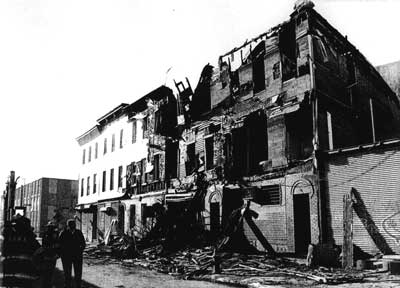
Figure 1.
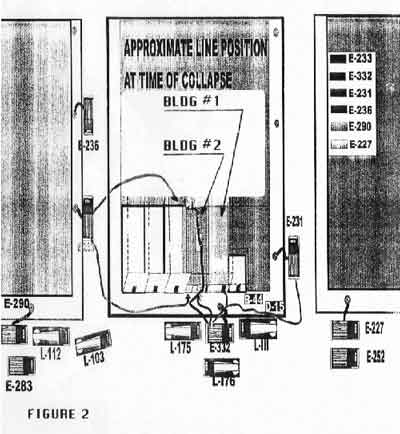
Figure 2.
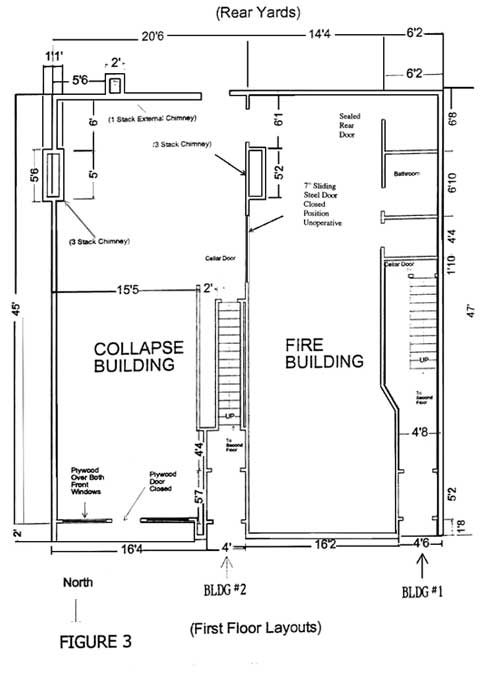
Figure 3.
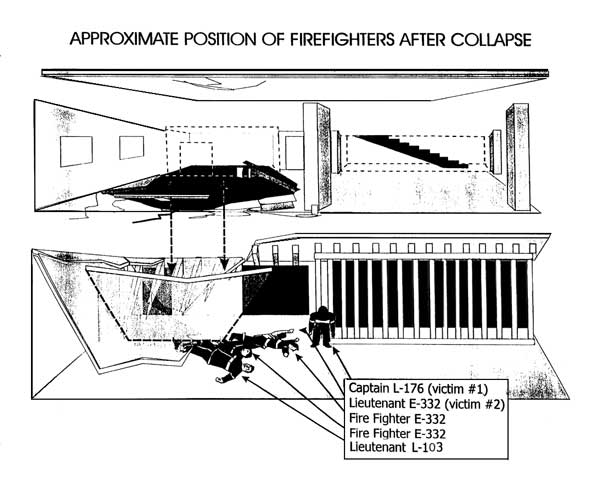
Figure 4.
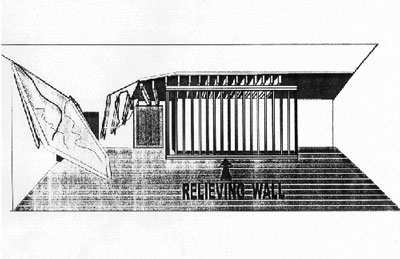
Figure 5.
Other photographs of incident site:
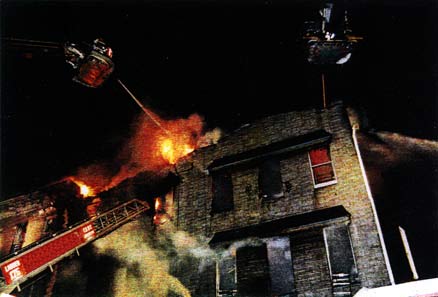
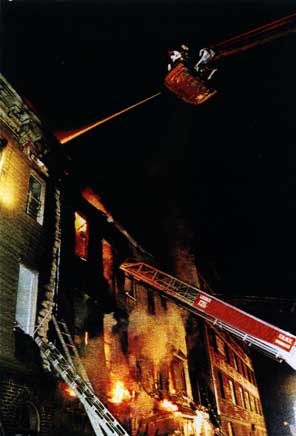
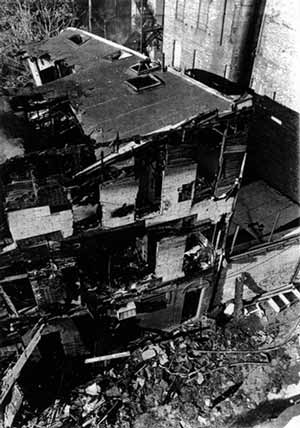
This page was last updated on 11/21/05
